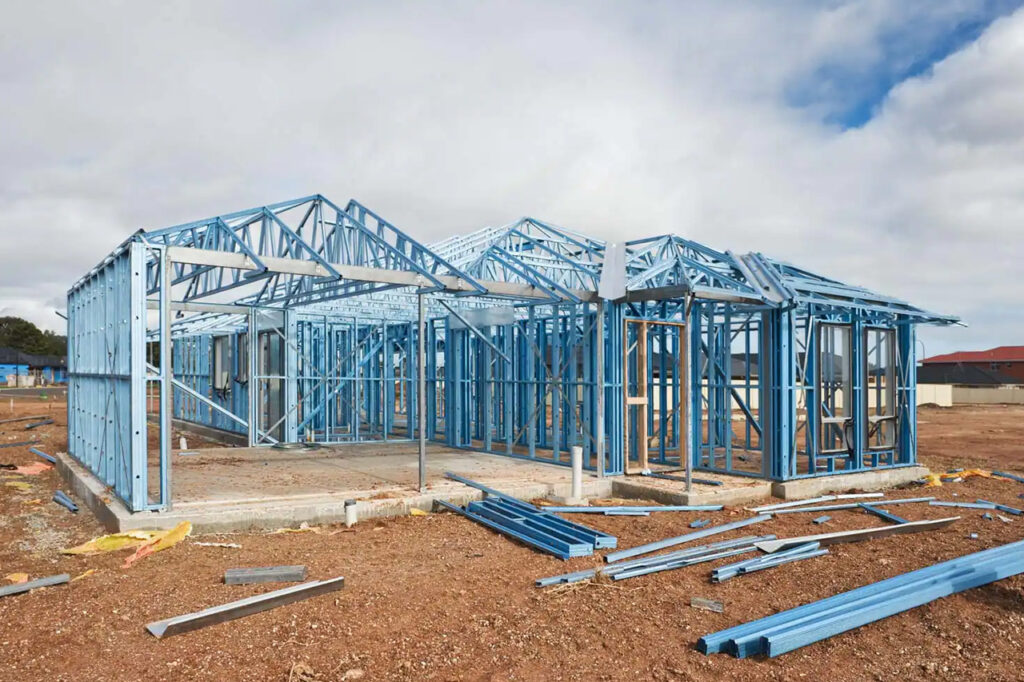Many property owners are still reeling from the effects of inflation and are now struggling to find cheaper homes so as not to ruin their savings, or what’s left of it.
Metal houses have gained significant popularity in recent years due to their affordability. They are also durable and lasts for decades.
This article from Lion Buildings explores the various factors that contribute to the cost-effectiveness of metal homes, highlighting their advantages over traditional construction methods.
Lower Material Costs
Steel, the primary material used in metal houses, is often more affordable than traditional building materials like wood or brick. Its widespread availability and the efficiency of modern manufacturing processes contribute to its cost-effectiveness. Additionally, steel’s strength allows for the use of fewer materials without compromising structural integrity, further reducing costs.
The recyclability of steel also plays a role in its affordability. Recycled steel is commonly used in construction, which not only lowers material costs but also supports environmental sustainability. This aspect makes metal houses an attractive option for budget-conscious and eco-friendly builders alike.
In many cases, suppliers offer bulk discounts on steel, especially when ordered for entire structures. This economic advantage helps reduce the total cost of the build, especially when compared to wood prices that fluctuate due to environmental regulations, forest management, and natural disasters. Unlike traditional materials that require extensive preparation or treatment, steel arrives ready to assemble, which saves money upfront.
Faster Construction Time
Metal houses often utilize prefabricated components, which are manufactured off-site and assembled quickly on location. This streamlined process significantly reduces construction time compared to traditional building methods. Shorter construction periods translate to lower labor costs and earlier occupancy, providing financial benefits to homeowners.
The precision of prefabricated metal components minimizes on-site adjustments and errors, ensuring a smoother construction process. This efficiency not only saves time but also reduces the likelihood of costly delays and rework. With less time spent on-site, there is less opportunity for weather delays or unexpected complications, which are common in traditional construction projects.
Many prefab steel building kits also come with pre-drilled holes, labeled parts, and detailed instructions. These features reduce the need for complex tools or highly skilled trades, further speeding up the build and reducing overall labor needs. The rapid assembly also reduces noise disturbances and neighborhood disruptions, a non-financial but appreciated benefit.
Reduced Labor Expenses
The simplicity and efficiency of assembling metal house components require less specialized labor, leading to reduced labor expenses. Workers can assemble prefabricated parts with basic tools, eliminating the need for extensive carpentry or masonry skills. This aspect is particularly beneficial in areas with high labor costs or shortages of skilled construction workers.
Furthermore, the reduced construction time associated with metal houses means that labor is needed for a shorter duration, further decreasing overall labor expenses. This cost-saving factor makes metal houses an appealing choice for budget-conscious builders.
Because fewer trades are involved in building metal houses, coordination and project management are easier and cheaper. There is less chance of subcontractor scheduling conflicts or work stoppages. Fewer people involved means a smaller margin for human error, helping the project stay on budget and on schedule.
Energy Efficiency
Metal houses can be designed with energy efficiency in mind, incorporating insulation and reflective roofing materials that reduce heating and cooling costs. Properly insulated metal homes maintain comfortable indoor temperatures, decreasing reliance on HVAC systems and lowering utility bills.
Additionally, the tight construction of metal houses minimizes air leaks, enhancing energy efficiency. This feature not only contributes to cost savings but also supports environmental sustainability by reducing energy consumption.
Some metal roofing materials are coated with special finishes that reflect solar heat rather than absorb it. Combined with quality insulation, this can result in a significant decrease in indoor temperatures during hot months. During winter, insulation helps retain warmth, ensuring that occupants stay comfortable without excessive energy use.
Lower Maintenance Costs
The durability of metal houses translates to lower maintenance costs over time. Steel structures are resistant to common issues that plague traditional homes, such as termite infestations, rot, and mold. This resilience reduces the need for frequent repairs and replacements, resulting in long-term savings for homeowners.
Moreover, metal surfaces are easier to clean and maintain, further decreasing maintenance efforts and expenses. The longevity and low upkeep requirements of metal houses make them a cost-effective housing solution.
Unlike wood, metal does not warp, crack, or split over time. It can handle harsh weather conditions without deteriorating. Paints and protective coatings for metal last longer than those used on wood, and when maintenance is eventually required, it is less extensive and more affordable.
Insurance Savings
Insurance premiums for metal houses are often lower due to their resistance to fire, pests, and severe weather conditions. Insurance companies recognize the reduced risk associated with metal structures, offering more favorable rates to homeowners. These savings can accumulate over time, contributing to the overall affordability of metal houses.
The enhanced safety features of metal homes not only provide financial benefits but also offer peace of mind to residents, knowing their homes are better protected against various hazards.
Metal buildings are non-combustible, which significantly lowers the risk of fire damage. In areas prone to wildfires or lightning strikes, this feature can be particularly beneficial. Lower insurance premiums over a thirty-year mortgage period can amount to thousands in savings, making the initial investment in a metal house more worthwhile.
Design Flexibility
Metal houses offer design flexibility, allowing for customizable layouts and aesthetic choices without significantly increasing costs. The strength of steel enables open floor plans and large spans without the need for load-bearing walls, providing more freedom in interior design.
This adaptability allows homeowners to tailor their living spaces to their specific needs and preferences, often at a lower cost than modifying traditional structures. The ability to personalize metal homes enhances their appeal and value.
Innovative cladding and paneling options can give metal homes a variety of looks, from rustic barn-style appearances to sleek, modern aesthetics. Interior finishes are equally customizable, supporting the same comfort and design ambitions as conventional homes. The shell of a metal home simply provides more room to grow into a creative vision.
Environmental Benefits
The construction of metal houses has environmental advantages that can translate to cost savings. The use of recycled steel reduces the demand for new raw materials, conserving natural resources and lowering production costs. Additionally, the energy efficiency of metal homes decreases utility expenses and carbon footprints.
These eco-friendly attributes may also qualify homeowners for tax incentives or rebates, further enhancing the affordability of metal houses. Building a metal home can be both a financially and environmentally responsible choice.
With global emphasis shifting toward greener living, choosing a metal home positions homeowners as forward-thinking and sustainable. Reducing waste, using recyclable materials, and optimizing energy consumption are increasingly important societal goals. A metal house supports all of these values.
Longevity and Resale Value
The durability and low maintenance requirements of metal houses contribute to their longevity, ensuring they remain in good condition for decades. This extended lifespan can enhance the resale value of metal homes, providing a return on investment for homeowners.
Prospective buyers may be attracted to the cost-saving features and modern designs of metal houses, making them competitive in the real estate market. The combination of affordability, durability, and aesthetic appeal positions metal homes as a valuable asset.
Metal buildings retain structural integrity much longer than many wood-framed homes. This resistance to decay and deterioration keeps the house in better shape over time, maintaining its marketability. As more people become aware of the benefits of steel homes, resale demand will likely increase.
Conclusion
Metal houses present an affordable and efficient alternative to traditional housing, offering numerous cost-saving benefits. From lower material and labor costs to energy efficiency and reduced maintenance expenses, metal homes provide financial advantages that appeal to a wide range of homeowners. Their durability, design flexibility, and environmental benefits further enhance their value, making them a smart choice for those seeking cost-effective and sustainable living solutions.
As housing markets fluctuate and consumers look for ways to build responsibly and economically, metal homes continue to stand out. Their unique blend of strength, style, and savings ensures they will remain a popular choice for years to come. Whether for first-time homeowners, downsizing retirees, or ambitious DIY builders, the metal house offers unmatched affordability and value.

